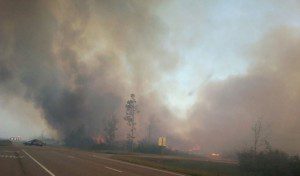A just-released report by the Florida Department of Law Enforcement (FDLE) investigating the Interstate 75 pile up in Alachua County, that killed 11 people in January, provides a scathing indictment of Florida Highway Patrol (FHP) on that smog/fog filled morning, although the review concluded that no one acted “with criminal intent.”
The report points out that lack of mandatory traffic control protocols; inadequate chain of command regarding responsibility for decision making related to the opening and closing of roads; poor dissemination of accurate information regarding fire incidents to all FHP members; inadequate public roadway signage to warn drivers regarding visibility; and inadequate interaction between FHP command personnel and other technical experts within the government that could assist FHP in making informed decisions, all contributed to the fatal events on January 29, 2012.
Despite earlier fatal traffic crashes under similar circumstances on Interstate 4 in 2008, in Polk County, FHP failed to properly put in place effective guidelines for troopers to follow when dealing with limited visibility on public highways, the report states.
On that deadly day on January 29, the investigation found Troopers failed to adequately communicate critical information amongst themselves regarding the fire on Paynes Prairie, although specific information on the fire had been provided by the Florida Forest Service to FHP’s communications center in Jacksonville.
While Lt. John Gourley of FHP made the determination to open Interstate 75, after evaluating conditions on the ground, “adequate resources were not dedicated to effectively monitor the environment,” although there were concerns that limited visibility would likely recur.
The reports states:
“Approximately twenty minutes prior to the fatal crashes, FHP Trooper Steven Downing reported the existence of dense smoke on US 441, in Paynes Prairie, less than one mile east of Interstate 75. However, no immediate measures were taken by FHP to actively monitor the conditions on Interstate 75 in Paynes Prairie.”
The report also hints at a cover up between officers of FHP, regarding warnings of conditions on Interstate 75.
Sgt. Bruce Simmons of FHP on two occasions had “voiced concerns” regarding the reopening of Interstate 75 to Lt. Gourley, the report states. But according to a memo written by Captain Coby Fincher with whom Simmons met the day after the crashes, he recanted his “verbal disagreement” with Gourley’s decision to open the roadway.
Sgt. Simmons sticks to his “concerns” and notes that Fincher’s memo is false and not an accurate relection of their meeting, according to the report.
The report makes several policy recommendations including:
- FHP policy related to traffic control should be clearly documented under the section within the FHP Policy Manual. Rather than suggesting “guidelines,” the policies should specify mandatory protocols to be followed during all incidents that affect traffic flow and roadway safety.
- Policy should mandate adherence to specific steps to be taken to evaluate information which may be pertinent to decision that can affect safety on the roadway.
- Policy should identify a clear level of command who responsibility is to make decision regarding the closing and opening of roads.
- Policy should dictate the dissemination of accurate information regarding fire incidents to all FHP members.
- Florida’s public roadway signage should be evaluated for its ability to appropriately warn travelers of conditions which may impact visibility on roadways.
See Full Report HERE.



